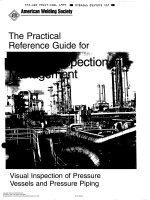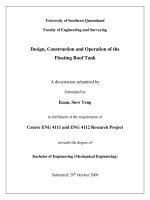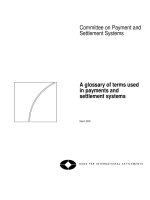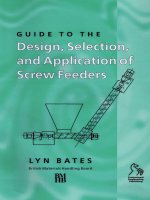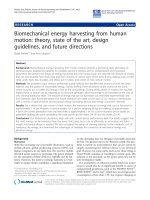DESIGN, INSPECTION, AND CERTIFICATION OF PRESSURE VESSELS AND PRESSURIZED SYSTEMS pot
Bạn đang xem bản rút gọn của tài liệu. Xem và tải ngay bản đầy đủ của tài liệu tại đây (916.75 KB, 85 trang )
JPR 1710.13C
(Formerly JPG 1710.13B)
Revision C
DESIGN, INSPECTION, AND
CERTIFICATION OF PRESSURE
VESSELS AND PRESSURIZED SYSTEMS
SAFETY AND MISSION ASSURANCE DIRECTORATE
SAFETY AND TEST OPERATIONS DIVISION
August 2004
National Aeronautics and
Space Administration
Lyndon B. Johnson Space Center
Houston, Texas
Verify that this is the correct version before use.
ii
Design, Inspection, and
Certification of Pressure
Vessels and Pressurized Systems
August 2004
Approved by
______(original signed by)______
Yolanda Y. Marshall
Director, Safety and Mission Assurance
____________(Original signed by)_____________
Stacey T. Nakamura
Chief, Safety and Test Operations
Verify that this is the correct version before use.
iii
Verify that this is the correct version before use.
iv
JPR 1710.13C
EFFECTIVE DATE: AUGUST 2004
EXPIRATION DATE: AUGUST 2009
CONTENTS
Change Record
Preface
1 Introduction 1-1
1.1 Purpose 1-1
1.2 Applicability 1-1
1.3 Responsibilities 1-1
1.4 Waivers/Deviations 1-3
1.5 Revisions and Changes 1-3
2 Reference Documents 2-1
2.1 NASA Documents 2-1
2.2 Military Specifications 2-1
2.3 National Codes and Standards 2-1
3 System Categorization 3-1
3.1 Category A, Code & Code-Like PV/S 3-1
3.2 Category B, PV/S & Components 3-1
3.3 Category C, Low-Energy/Low-Risk PV/S 3-1
3.4 Category D, Isolated/Contained PV/S 3-1
3.5 Category E, Exempt PV/S 3-1
4 Design 4-1
4.1 Specific Design Requirements for Category A, Code & Code-Like PV/S 4-1
4.2 Category B, PV/S & Components 4-5
4.3 Specific Design Requirements for Category C, Low-Energy/Low-Risk PV/S 4-5
4.4 Specific Design Requirements for Category D, Isolated/Contained PV/S 4-6
4.5 Specific Design Requirements for Category E, Exempt PV/S 4-6
Verify that this is the correct version before use.
v
5 Documentation 5-1
5.1 Category A, Code & Code-Like PV/S 5-1
5.2 Category B, PV/S & Components 5-2
5.3 Category C, Low-Energy/Low-Risk PV/S 5-2
5.4 Category D, Isolated/Contained PV/S 5-2
5.5 Category E, Exempt PV/S 5-2
5.6 Incomplete Documentation 5-2
5.7 Continuous Records 5-3
6 Manufacturing and Installation 6-1
6.1 Specific Manufacturing and Installation
Requirements for Category A, Code & Code-Like PV/S 6-1
6.2 Category B, PV/S & Components 6-2
6.3 Specific Manufacturing and Installation
Requirements for Category C, Low Energy/Low Risk PV/S 6-2
6.4 Specific Manufacturing and Installation
Requirements for Category D, Isolated/Contained PV/S 6-2
6.5 Specific Manufacturing and Installation
Requirements for Category E, Exempt PV/S 6-2
7 Tests and Inspections 7-1
7.1 Category A, Code & Code-Like PV/S 7-1
7.2 Category B, PV/S & Components 7-2
7.3 Category C, Low-Energy/Low-Risk PV/S 7-2
7.4 Category D, Isolated/Contained PV/S 7-3
7.5 Category E, Exempt PV/S 7-3
7.6 Noncompliance 7-3
7.7 Testing Exemptions 7-3
7.8 Inspection Variances 7-5
8 Tagging 8-1
8.1 Category A, Code & Code-Like PV/S 8-1
8.2 Category B, PV/S & Components 8-3
8.3 Category C, Low-Energy/Low-Risk PV/S 8-6
8.4 Category D, Isolated/Contained PV/S 8-6
Verify that this is the correct version before use.
vi
8.5 Category E, Exempt PV/S 8-6
8.6 Class 2 Thickness Examination Tag 8-7
8.7 Class 3 Internal Visual Inspection Tag 8-7
9 Pressure Systems Inventory/Recall System 9-1
9.1 Existing Systems and Components 9-1
9.2 New Systems 9-1
9.3 New Components 9-1
9.4 System and Component Data Maintenance 9-1
9.5 System and Component Inspection Maintenance 9-1
9.6 Inspection Notifications 9-2
9.7 Status Reports 9-2
9.8 Delinquency Reports 9-2
9.9 Nonconformance 9-2
10 Modifications and Repairs 10-1
10.1 Modifications 10-1
10.2 Repairs 10-1
10.3 Status Change 10-1
TABLES
7-1 Category A Component Periodic Test and Inspection Requirements 7-6
7-2 MAWP and Minimum Bend Radius for Seamless Stainless Steel
Tubing Not Subject to Hydrostatic Testing 7-7
7-3 MAWP and Minimum Bend Radius for Annealed Seamless
Copper Tubing Not Subject to Hydrostatic Testing 7-7
FIGURES
1-1 JSC PV/S Certification Program Flowchart 1-4
3-1 Pressure System Categorization Decision Tree 3-2
4-l Pressure System Design Review Record 4-7
6-1 Weld Inspection Record 6-3
8-1 Category A Pressure System Certification Tag 8-2
8-2 Pressure Relief Valve Certification Tag 8-2
Verify that this is the correct version before use.
vii
8-3 Flex Hose Certification Tag 8-4
8-4 Pressure Test Tag 8-4
8-5 Category B Pressure System Certification Tag 8-5
8-6 Category B Component Tag 8-5
8-7 Category C Recertification Not Required Tag 8-6
8-8 Category D Pressure System Certification Tag 8-7
8-9 Class 2 Thickness Examination Tag 8-8
8-10 Class 3 Internal Visual Inspection Tag 8-8
B-1 JSC Pressure Systems Manager's Office Waiver Request B-2
C-1 Category C, Low-Energy/Low-Risk Request C-2
E-1 Pressure System Condition Report E-2
F-1 JSC form 366-S, System Inspection/Inventory Input form F-9
F-2 JSC form 366-C, Component Inspection/Inventory Input form F-10
F-3 JSC form 324-S, System Inspection Notification F-11
F-4 JSC form 324-C, Component Inspection Notification F-12
APPENDICES
A Procedure for Qualification/Certification of Pressure Systems Engineers A-1
B Procedure for PV/S Waiver Request B-1
C Procedure for Completing A Category C, Low Energy/Low Risk PV/S Request C-1
D Pressure Testing Requirements D-1
E Procedure for Documentation and Correction of Pressure System/
Component Deficiencies E-1
F Procedure for Entering Data Into The Pressure Systems Inventory/Recall System
F-1
G Procedure for Qualification/Certification of Pressure Systems Specialists G-1
H Requirements for Performing Set Pressure Tests of Pressure Relief Valves H-1
I Glossary I-1
Verify that this is the correct version before use.
viii
Verify that this is the correct version before use.
ix
CHANGE RECORD
Rev. Date Originator/Phone Description
B 1994
C 2004 Paul Torrance/31883 Update to document, revise to
JPR
Change
1
12/17/2004 Alice Ayala (Per instructions from
NT/Jeanette Siggins)
Pen and Ink Addition to
Paragraph 3.5.
Change
2
4/13/2005 Paul Torrance/31883 Add bullet g to Paragraph 3.5
Verify that this is the correct version before use.
x
Verify that this is the correct version before use.
xi
PREFACE
P.1 PURPOSE
Presented in this document are requirements for design, inspection, and certification of
ground-based pressure vessels and pressurized systems (PV/S) owned and/or operated by JSC
and of all PV/S used on JSC property. JSC organizations must implement these requirements on
PV/S for which they have the responsibility.
P.2 APPLICABILITY
This applies to all PV/S used on JSC property.
P.3 AUTHORITY
Comments and questions concerning this document should be directed to the JSC Pressure
Systems Manager, mail code NS2, member of the Safety and Test Operations Division.
P.4 REFERENCES
N/A
P.5 CANCELLATION
This document remains in effect for five years.
This document supersedes JHB 1710.13B, "Design, Inspection, and Certification of Pressure
Vessels and Pressurized Systems."
____________________________
Jefferson D. Howell
Director
Lyndon B. Johnson Space Center
Verify that this is the correct version before use.
xii
Verify that this is the correct version before use.
xiii
Verify that this is the correct version before use.
1-1
SECTION 1
INTRODUCTION
1.1 PURPOSE
All pressure vessel/systems (PV/S) must be certified as safe to operate from a pressure viewpoint
before use and must be recertified periodically after initial certification. This is in accordance
with the requirements of NASA Policy Directive (NPD) 8710.5, NASA Safety Policy for
Pressure Vessels and Pressurized Systems, and JSC Policy Directive (JPD) 1710.1, Design,
Inspection, and Certification of Pressure Vessels and Pressurized Systems. This document
provides implementation instructions to satisfy these requirements at JSC.
Certification is a series of steps that must be performed in order to ensure operational safety of a
PV/S. This document discusses these steps in the logical sequence in which the steps should be
performed. See figure 1-1 for a flowchart of steps necessary to achieve certification.
Recertification is a recurring process that is accomplished by successfully completing scheduled
tests and inspections to show that a previously certified PV/S continues to be safe to operate.
The PV/S user organization will ensure that operators are qualified and trained; will review PV/S
personnel hazards, such as toxicity, flammability, corrosiveness, and temperature; and will take
necessary precautions. Additional requirements for the control of hazards are contained in JSC
Procedures and Guidelines (JPG) 1700.1, JSC Safety and Total Health Handbook, as revised.
1.2 APPLICABILITY
The provisions of this instruction apply to all ground-based PV/S, both new and existing, which
are owned and/or operated by JSC and all PV/S that are used on JSC property. PV/S that are an
integral part of NASA-owned or operated aircraft and are covered by U.S. Air Force technical
orders are exempt from the requirements of this document.
1.3 RESPONSIBILITIES
a. Safety and Mission Assurance (S&MA)
The S&MA Directorate must appoint a JSC Pressure Systems Manager (PSM) who is
responsible for overall management of the PV/S certification program, including
implementation, enforcement, coordination, status reporting, and waiver approval on all
activities of the JSC PV/S certification program. The Pressure Systems Manager's office
(PSMO) is responsible for:
(1) Providing PV/S design assistance to operating organizations
(2) Reviewing and approving all PV/S designs to ensure compliance with applicable codes
and standards
(3) Reviewing and approving PV/S certification, recertification, inspection, and testing
procedures for adequacy of safety considerations
(4) Performing PV/S inspections
(5) Witnessing PV/S tests
Verify that this is the correct version before use.
1-2
(6) Certifying and re-certifying worthiness of PV/S
(7) Performing audits of White Sands Test Facility (WSTF) and government-owned,
contractor-operated (GOCO) plants to ensure that Center-specific procedures that meet
the requirements of NPD 8710.5 have been developed and are being properly
implemented
(8) Issuing revisions to this document
The PSM must appoint a JSC Pressure Systems Engineer (PSE) to review the ground-based
PV/S designs and initial waiver requests. A pressure systems specialist (PSS) provided by
S&MA and responsible to the PSM performs the certification of all Category A, C, and D PV/S.
The PSM has authority to delegate certain design review and inspection functions to others in
support of the certification program.
b.
Other Directorates and Operating Organizations
Other JSC directorates and operating organizations are responsible for:
(1) designing and fabricating their PV/S to applicable codes and standards outlined in this
document,
(2) obtaining an objective PV/S design review from a certified PSE,
(3) preparing applicable procedures,
(4) scheduling with PSMO initial and periodic PV/S inspections and tests,
(5) performing PV/S tests,
(6) creating and maintaining PV/S documentation files,
(7) preparing and submitting formal inputs to the PSMO for the computerized PV/S
Inventory/Recall System (PSIRS).
Operating organizations are authorized to have a certified PSE, approved by the PSM as outlined
in appendix A, to support their PV/S activities.
c.
On-Site Contractors
On-site contractors owning, using, fabricating, modifying, or maintaining PV/S on JSC property
are responsible for:
(1) designing and fabricating their PV/S to applicable codes and standards referenced in this
document,
(2) obtaining an objective PV/S design review from a certified PSE,
(3) preparing applicable procedures,
(4) scheduling with PSMO initial and periodic PV/S inspections and tests,
(5) performing PV/S tests,
(6) creating and maintaining PV/S documentation files,
(7) preparing and submitting formal inputs to the PSMO for the computerized PSIRS.
Verify that this is the correct version before use.
1-3
d. Structural Engineering Division
The Structural Engineering Division (SED) is responsible for approving all flight PV/S and
completing an Operation and Configuration Control Plan (OCCP) for all flight PV/S tested at
JSC; for providing assistance to the JSC PSMO and other organizations on all other PV/S
designs and/or design reviews when requested; and for making recommendations on waiver
requests. The support must include such items as material analysis, stress and fracture mechanics
analysis, and nondestructive evaluation.
e.
Off-Site JSC Organizations
Off-site JSC organizations (WSTF and GOCO plants under JSC’s purview) are responsible for
developing a Pressure System Certification Program that meets the requirements of NPD 8710.5;
for developing and submitting a plan and associated procedures for the implementation of these
requirements to the JSC PSM for review and approval; and for submitting periodic status reports
to the JSC PSM. Use of the JSC computerized PV/S inventory/recall system is not mandatory.
1.4 WAIVERS/DEVIATIONS
If the requirements of this document cannot be met under unique circumstances exist, the
cognizant technical organization must prepare a waiver request with supporting technical
rationale and submit it to the JSC PSM for approval. Submit requests by using JSC form 1881,
JSC Pressure Systems Manager’s Office Waiver Request.
The WSTF PSM approves or disapproves WSTF waivers. The GOCO plant PSM approves or
disapproves GOCO plant waivers.
1.5 REVISIONS AND CHANGES
The JSC PSM controls all revisions and changes to this document. Submit requests for changes
to the JSC PSM in writing with sufficient rationale and/or technical justification. This document
will be reviewed on a periodic basis and changes will be incorporated in accordance with the
JSC Document and Data Control procedure.
Verify that this is the correct version before use.
1-4
JSC PV/S CERTIFICATION PROGRAM FLOW CHART
INITIAL CERTIFICATION RECERTIFICATION
NOT APPROVED
APPROVED
NOT
APPROVED
NOT APPROVED
APPROVED
APPROVED
APPROVE
USER DESIGNS PV/S
SECTION 4.0
DESIGN REVIEWED
BY PSE
S
E
C
TI
O
N 4.
0
PV/S MODIFIED
SECTION 10.0
PV/S NOT MODIFIED
SECTION 9.0
PSDS ISSUES
COMPONENT AND/OR
SYSTEM INSPECTION
NOTIFICATION
SECTION 9.0
DOCUMENTATION FILE
DEVELOPED BY USER
SECTION 5.0
PV/S MANUFACTURED
INSTALLED
SECTION 6.0
PSMO WITNESSES SYSTEM
AND COMPONENT TESTS,
PERFORMS INSPECTIONS,
AND REVIEWS
DOCUMENTATION FILE
SECTION 7.0
PV/S TAGGED TO
INDICATE CERTIFICATION
SECTION 8.0
PV/S
CERTIFIED
PSCR WRITTEN BY
PSMO APPENDIX
E
WAIVER REQUESTED
BY USER
APPENDIX B
USER DISPOSITIONS
PSCR
APPENDIX E
PSM EVALUATES
WAIVER REQUEST
APPENDIX B
PSMO EVALUATES
DISPOSITION
APPENDIX E
USER CORRECTS
DISCREPANT
CONDITION
APPENDIX B
USER PERFORMS
CORRECTIVE ACTION
APPENDIX E
PV/S OPERATES
UNDER WAIVER
STATUS
Figure 1-1. JSC PV/S Certification Program Flowchart
Note: Not applicable to Category B systems
Verify that this is the correct version before use.
2-1
SECTION 2
REFERENCE DOCUMENTS
The latest revisions of the following documents are applicable to the extent specified herein. The
requirements of this document comply with the minimum requirements of the referenced
documents. Any additional or more restrictive requirement prescribed by this document is
considered mandatory.
2.1 NASA DOCUMENTS
a. JPD 1710.1, Design, Inspection, and Certification of Pressure Vessels and Pressurized Systems
b. JPG 1700.1, Johnson Space Center Safety and Health Handbook
c. NASA Reference Publication 1113, Design Guide for High Pressure Oxygen Systems
d. NPG 1700.6, Guide for Inservice Inspection of Ground-Based Pressure Vessels and Systems
e. NPD 8710.5, NASA Safety Policy for Pressure Vessels and Pressurized Systems
f. ANSI/AIAA S-080-1998, Space Systems, Metallic Pressure Vessels, Pressurized Structures,
and Pressure Components
g. ANSI/AIAA S-081-2000, Space Systems, Composite Overwrapped Pressure Vessels
h. SW-E-0002, Space Shuttle Program Ground Support Equipment General Design Requirements
i. SN-W-0002, General Specification Welding, Welder Certification and Weld Categories
j. JPD 5335.1, Lyndon B. Johnson Space Center Quality Policy
k. JPD 5335.3, Lyndon B. Johnson Space Center Quality Management System Quality Manual
2.2 MILITARY SPECIFICATIONS
Air Force Technical Order 00-25-223, Integrated Pressure Systems and Components (Portable
and Installed)
2.3 NATIONAL CODES AND STANDARDS
a. American Society of Mechanical Engineers (ASME) Boiler and Pressure Vessel Code
b. ASME Codes for Pressure Piping, B31
c. American Petroleum Institute (API) 510, Pressure Vessel Inspection Code
d. Code of Federal Regulations (CFR) 49 (Department of Transportation, or DOT Code)
e. ANSI/NB-23 National Board Inspection Code
f. American Society of Testing Materials (ASTM) Specifications
g. Compressed Gas Association (CGA) Requirements
h. Code of Federal Regulations (CFR) 29 Part 1910 (OSHA)
Verify that this is the correct version before use.
2-2
i. ASME B40.1-1991, Gauges – Pressure Indicating Dial Type – Elastic Element
j. ASME Performance Test Code 25, Pressure Relief Devices
k. Society of Automotive Engineers (SAE) J-513, Refrigeration Tube Fittings – General
Specifications
Verify that this is the correct version before use.
3-1
SECTION 3
SYSTEM CATEGORIZATION
Categorize PV/S at JSC as indicated in the decision tree presented in Figure 3-1 (categories
listed in this figure are further defined below). Categorize all flight PV/S used or tested at JSC as
category B or D and all Orbiter payloads used or tested at JSC as category B.
3.1 CATEGORY A, CODE AND CODE-LIKE PV/S
a.
Code
These PV/S conform to consensus codes and standards (ASME, DOT, ANSI, etc.).
b.
Code-Like
These PV/S do not fall within the scope of any of the referenced codes and standards, yet are
designed in accordance with code formulas, documented stress values, and code safety factors.
3.2 CATEGORY B, PV/S AND COMPONENTS
Category B hardware generally is designed to aerospace standards (e.g. ANSI/AIAA S-080-1998,
ANSI/AIAA S-081-2000, etc.). These PV/S are typically weight-efficient designs intended for flight
hardware use (in balloon, aircraft, rocket, or space applications) or flight hardware ground
simulation. They may include experimental hardware or other projects requiring lightweight or
unique designs.
The Materials and Processes Branch (ES4), in conjunction with the PSM, must ensure that
Category B PV/S or components are safe for pressurization on JSC property. An OCCP, as
defined in paragraph 5.2, must control configuration and pressurization of Category B PV/S. The
Materials and Processes Branch must approve the OCCP.
3.3 CATEGORY C, LOW-ENERGY/LOW-RISK PV/S
These PV/S have a combination of pressure, contained volume, and service fluid such that the
maximum potential energy, if released, would not cause serious injury to personnel, significant
damage to facilities, or other harmful impacts.
3.4 CATEGORY D, ISOLATED/CONTAINED PV/S
These are unique systems that are isolated, protected, contained, or restrained in such a manner that
the maximum catastrophic failure could not be harmful to personnel, facilities, or equipment.
3.5 CATEGORY E, EXEMPT PV/S
The following PV/S are exempt from certification because of their inherently low energy or their
national record of operation without serious incident:
a. Water systems (150 psig or less and at 110ºF or less)
b. Commercially manufactured heating ventilation, and air conditioning systems (HVAC),
refrigerators and freezers used expressly for their intended purpose.
c. Fire Protection Systems; the requirements for these systems are included in JPG 1700.1
d. Vacuum Vessel/System, 2 cu. ft. or smaller without positive locking closure
Verify that this is the correct version before use.
3-2
e. Low-pressure (125 PSIG or less) natural gas supply line under the scope of NFPA 54-2000
f. Commercially manufactured welding/brazing/cutting equipment including gas regulators,
bottles, hoses, and associated apparatus used expressly for their intended purposes.
g. Sonny Carter Training Facility (SCTF) Neutral Buoyancy Laboratory (NBL) scuba gear
regulators and flexible hoses, provided that (1) each regulator and its associated flexible
hoses have unique traceability and (2) the flexible hoses are hydrostatically tested annually
to meet the requirements of OSHA 29 CFR-1910.430. This exemption is applicable only to
scuba gear components and is not applicable to umbilical hoses that provide breathing gas to
suited subjects undergoing EVA training in the NBL.
Verify that this is the correct version before use.
3-3
CATEGORY
A
CATEGORY
E
CATEGORY
C
START
CAN THE PV/S BE ISOLATED
OR CONTAINED AS OUTLINED
IN SECTION 3.4?
CATEGORY
B
CATEGORY
D
YES
NO
IS THE PV/S FLIGHT
HARDWARE?
IS THE PV/S DESIGNED,
MANUFACTURED, AND TESTED
IN ACCORDANCE WITH ASME,
ANSI, OR DOT CODES?
IS THE PV/S ONE OF THE
EXCLUSIONS PRESENTED IN
SECTION 3.5?
DOES THE PV/S MEET THE
DESIGN, FABRICATION, AND
TEST REQUIREMENTS OF
ANSI/AIAA S-080-1998 OR
ANSI/AIAA S-081-2000?
DOES THE PV/S MEET THE
LOW-ENERGY/LOW-RISK
CRITERIA ESTABLISHED IN
APPENDIX C?
CAN THE PV/S BE ISOLATED
OR CONTAINED AS OUTLINED
IN SECTION 3.4?
YES
YES
YES
YES
YES
YES
NO
NO
NO
NO
NO
NO
APPLY FOR A PRESSURE SYSTEM
WAIVER AS OUTLINED IN APPENDIX B
Figure 3-1. Pressure System Categorization Decision Tree
Verify that this is the correct version before use.
4-1
SECTION 4
DESIGN
All new ground-based PV/S that JSC owns and/or operates and all PV/S used on JSC property
must be designed, manufactured, inspected, and tested in accordance with applicable codes and
standards. It is not in the scope of this document to outline design requirements for test articles,
experimental PV/S, or flight PV/S, as they will be designed to meet specific program and/or
project requirements. These PV/S may, however, be tested and/or used at JSC if subjected to
sufficient technical and safety reviews to verify the design, operating procedures, and physical
facilities provide adequate personnel and equipment protection.
4.1 SPECIFIC DESIGN REQUIREMENTS FOR CATEGORY A, CODE AND CODE-
LIKE PV/S
Design all Code PV/S to the requirements of the applicable codes and standards listed below.
Design all Code-like PV/S with the formulas of the most applicable code or standard that is
listed below. Use the code design stress for those materials listed, or code equivalent safety
factor for materials not listed. In any case, the safety factor must not be less than the value that is
specified by the most applicable code or standard being used.
The PSMO maintains a copy of all codes and standards listed below and can provide
organizations with technical guidance in the design of Category A PV/S.
a.
Applicable Codes and Standards
Design Category A PV/S to the applicable sections of the codes and standards listed below; other
codes and standards may be used if approved by the PSMO.
(1) Permanent Pressure Vessels. Design all permanent pressure and vacuum vessels to the
requirements of Section VIII, Division 1, 2 or 3, of the ASME Boiler and Pressure
Vessel Code.
(2) Mobile/Portable Pressure Vessels. Design all mobile/portable pressure and vacuum
vessels that are used on site and at anytime leave the site to the requirements of CFR
49.
(3) Piping/tubing systems. Design all piping and tubing systems to the applicable ASME
B31 Pressure Piping Code.
(4) Components. Design all components to the applicable ASME, ANSI, or ASTM
standard. When commercially available components are used, use the manufacturer's
service rating to establish maximum allowable working pressure (MAWP) subject to
PSMO review and acceptance.
b.
Loadings
Design all PV/S for at least the most severe condition of coincident pressure and temperature
expected in operation. In addition to pressure, consider the effects of the following loadings in
the design:
(1) Weight of PV/S and contents
Verify that this is the correct version before use.
4-2
(2) Static reactions from weight of attached equipment
(3) Cyclic and dynamic reactions caused by pressure or thermal variations, flow-induced
vibrations, or attached equipment and mechanical loadings
(4) Wind, snow, ice, and seismic reactions
(5) Impact reactions such as those due to fluid shock
(6) Temperature gradients and thermal expansion
c.
Temperature Considerations
The temperature used in the design of the PV/S must not be less than the mean metal temperature
(through the thickness) expected under operating conditions. If necessary, determine the metal
temperature by computation using accepted heat transfer procedures or by measurement from
equipment in service under equivalent operating conditions.
d.
Materials Selection
It is not in the scope of this document to detail material compatibility and selection criteria. The
designers are responsible for familiarity with the materials and fluids with which they are
working. Use the following guidelines to aid in the selection of materials:
(1) Select only materials listed by appropriate codes, standards, and technical literature as
compatible for each specific service.
(2) Consider all operating conditions such as temperature, pressure, and fluid compatibility
before selecting an appropriate material.
(3) Materials compatible with a service fluid at one temperature and pressure may not be
compatible at another temperature and pressure.
(4) Select materials compatible with each other as well as with the service fluid.
(5) When operating temperatures vary greatly, consider the stresses caused by thermal
expansion.
e.
Welded Designs
Design all weldments in a PV/S, including attachments made to pressure retaining boundaries, to
meet the requirements of the ASME B31 Pressure Piping Codes and/or the ASME Boiler and
Pressure Vessel Codes, as applicable. Drawings and/or other design specifications used for
welded assemblies must contain complete information detailing joint geometry; weld type, size,
and location; material type and specification; preheat, interpass, and postweld heat treat
requirements; and any nondestructive testing required. All welding symbols used must meet the
requirements of AWS A2.4, Symbols for Welding and Nondestructive Testing.
f.
Overpressure Protection Requirements
Equip all Category A PV/S with appropriate pressure relief devices set to function at or below
MAWP to prevent over-pressurization and possible catastrophic explosion due to component
failure (failed regulator, runaway heater, etc.), ambient temperature influences, or external
sources of heat (fire). These devices must be:
(1) Sized to prevent pressure from rising more than 10% or 3 psi after initial cracking or
opening, whichever is greater, above MAWP, except:
Verify that this is the correct version before use.
4-3
(a) when multiple pressure relief devices are provided, they must prevent the pressure
from rising more than 16% or 4 psi, whichever is greater, above the MAWP; and
(b) when supplemental pressure devices are installed to protect against excessive
pressure created by exposure of PV/S to fire or other unexpected sources of
external heat, they must prevent the pressure from rising more than 21% above
the MAWP.
(2) Selected on the basis of their intended service; and
(3) Installed in accordance with the requirements of the applicable ASME Code Section
and in such a way so that they are readily accessible for inspection and cannot be
rendered inoperative.
Take care to select the pressure relief device set pressure such that the pressure relief device does
not function due to normal operations and pressure fluctuations. As a general rule, pressure relief
valve set pressure should be selected at a minimum of 30 psig above operating pressure when
operating at 300 psig or less, and 10% above operating pressure when operating above 300 psig.
Burst disks, because of their susceptibility to creep, should be selected such that their burst pressure
is at least 30% above operating pressure. In any case, the pressure relief device set pressure must
not exceed the PV/S's MAWP. Adherence to these guidelines will prevent unexpected simmering
of relief valves or rupture of a burst disk.
Whenever liquids are being used at or near temperatures and pressures where phase change could
occur (cryogenic systems, refrigeration systems, steam systems, etc.), carefully select pressure
relief devices to ensure adequate discharge capacity is provided. Carefully locate the pressure relief
devices so that closure of control devices (valves) will not block pressure relief valve protection. A
pressure relief device must be installed between valves that could produce a liquid locked condition
subject to phase change.
g.
Overpressure Protection Exemptions for Pressure Vessels
A pressure relief device need not be installed on a pressure vessel when the source of pressure
and temperature influence is external to the vessel and is under such positive control that the
pressure in the vessel cannot exceed the MAWP and the design is approved by the PSMO.
h.
Specific Overpressure Protection Exemptions for Piping (including Tubing) Systems
A pressure relief device need not be installed in areas of a piping system that are designed for the
maximum pressure that can possibly be developed (including component failure).
i.
Piping (including Tubing) Flexibility Requirements
Design piping systems to have sufficient flexibility to prevent thermal, mechanical, or
acoustical-induced expansion or contraction from causing any of the following:
(1) Failure of piping or supports from overstress or fatigue
(2) Leakage at joints
(3) Detrimental stress or distortion in piping or in connected equipment




